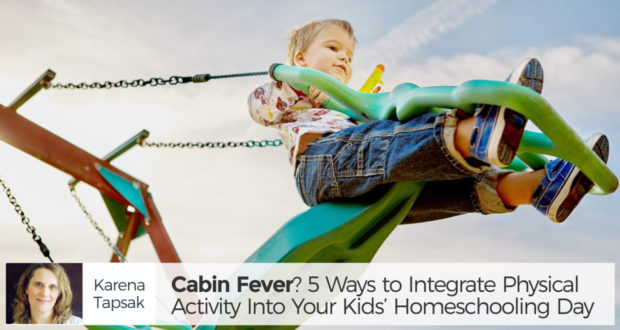Summary
Mother of 6 with 10 years of homeschooling under her belt, Karena Tapsak shares her tried and true ideas to develop good exercise habits!It’s February, and your children are as squirrely as those little creatures outside your window.
Everyone has cabin fever, including you!
You suddenly realize that you haven’t been making time for outside exercise and play. I mean, who wants to? It’s so cold! You look around—what can I do, in addition to using the Seton P.E. lesson plans, to get the wiggles out of the kids, yet make it fun so that they will develop good exercise habits as they grow up? And how can I find the time?
As the mom of six children, I have discovered that physical movement during the day is essential to keeping them on task for their studies as well as getting along with their siblings and me. I have a few ideas that might help.
1. Don’t wait until the day is over, or you might not do it.
We have lots of ground to cover as homeschooling parents—many subjects, children, and activities—and it seems like we never have enough time.
But integrating a little activity in the day doesn’t have to be long and orchestrated.
For example, my seven-year-old son loves it when I yell out, “Give me 20 jumping jacks,” to which he responds, “I’ll give you at least 100!” He will then proceed to show us whatever crazy thing they are doing in martial arts class, and then pretty soon everyone is on the floor laughing!
2. Make it play, not work.
The kids are much more receptive to exercise if I don’t call it that. The second I say, “You need some exercise,” I am bound to be met with whining and complaining. But if I say that we should race to see who can find the reddest maple leaf, suddenly it is a game.
This works especially for boys who love competition (and I have five of them, so competition seems never-ending around here!), but my daughter loves it, too.
In addition to scavenger hunts, other games that we like are Simon Says, Duck Duck Goose, and good old-fashioned tag. Simon Says is great because you can give simple commands to do physical activities and the children can even take turns being Simon, which they love. The game of Duck Duck Goose is fun for little ones, and the older kids can run it for you.
Finally, there are so many variations of tag that the kids can play just about anywhere.
And what makes a good game but a reward at the end? You can use exercise/game time as a carrot for their coveted media time after school (if they are allowed), or whatever else motivates them.
Kids love games and rewards, and you are meeting a homeschooling goal. They just think it’s fun, and that’s the point.
3. If your schedule allows, sign them up for sports in your community.
There are many ways to do this. In our case, all of our children have played AYSO (American Youth Soccer Organization) soccer and taken tennis lessons at the local park. Some of them have also played Catholic Youth Organization basketball (through the church) and community baseball.
In some states, you may want to take advantage of equal access laws which allow homeschoolers to participate in sports in the local public schools.
In other areas, where the density of homeschoolers is higher, homeschoolers have formed their own sports teams, clubs and leagues.
Check around in your area—you might be surprised at the variety of offerings. If your children don’t like team competition, martial arts might be a good fit.
This seems to be a favorite among homeschoolers that I know, especially because it is year-round, individual, and goal-oriented. Different belts/awards and visible progress are big motivators in my house.
4. Be creative.
In the winter, playing outside in the snow, building forts or sledding are good ways for the kids to get fresh air and burn off some energy. Hiking back up those hills is not easy, nor is trudging in deep snow and digging out forts.
When we lived in the country, just getting the mail (1/2 mile round trip) or taking out the garbage were ways I could incorporate physical activity into the day and break up their work time. I also used to have the “walking around the loop for media time” exercise program.
It went something like this: for each loop around the field, the children were given a certain amount of time on the computer or television. At one point, they were doing miles of walking or running just to be able to earn this coveted time.
But you don’t need lots of land or a country lifestyle to have a similar program. If you live in town and your kids are old enough, you can have the kids run short errands to the store for you, drop off mail, etc. The possibilities are endless, depending on your particular situation.
5. Try to involve your children in doing what you love.
For our family (and especially me, since I am home the most with them) this means running, biking, hiking, gardening, and swimming.
I have done several 5k races with the older children and, in better weather, we like to take hikes to our many state parks, bike in our neighborhood, and swim at our friend’s pool or the YMCA.
I usually have a large vegetable and flower garden that everyone helps to maintain by weeding, mulching, mowing, and eventually harvesting.
Not only does gardening provide physical activity, but it is a wonderful way to teach natural science and how to care for God’s creation—both good homeschooling goals.
6. Don’t forget Fido!
If you have a dog, have older children be responsible for taking him for a walk. This has been a good excuse to get the kids out the door, especially the older ones who don’t have that “pent up energy” that the younger kids have, but still need to get out once in a while.
Using these six tips on getting your kids moving should do wonders for your homeschool. Not only will everyone get fresh air and exercise, but studies have shown that physical activity makes kids (and adults) more productive.
Breaking up the day and getting children to move helps them tremendously to focus and will help them develop good habits that they will carry on into adulthood.
And that is what homeschooling is all about— not only teaching our children facts, but helping them to develop habits that will last a lifetime.

 Seton Magazine Catholic Homeschool Articles, Advice & Resources
Seton Magazine Catholic Homeschool Articles, Advice & Resources

